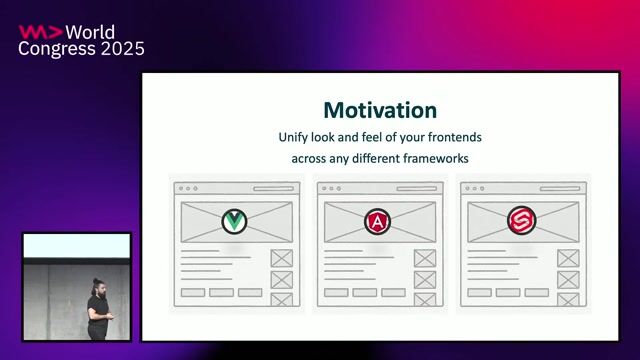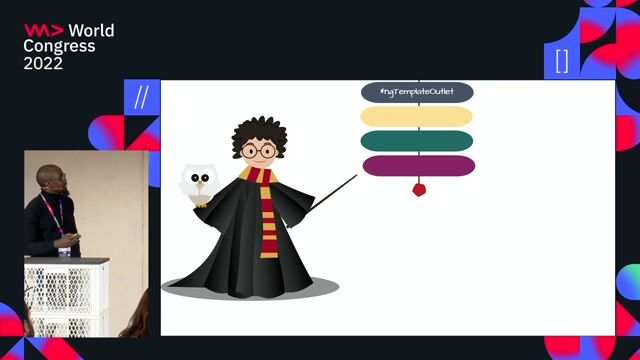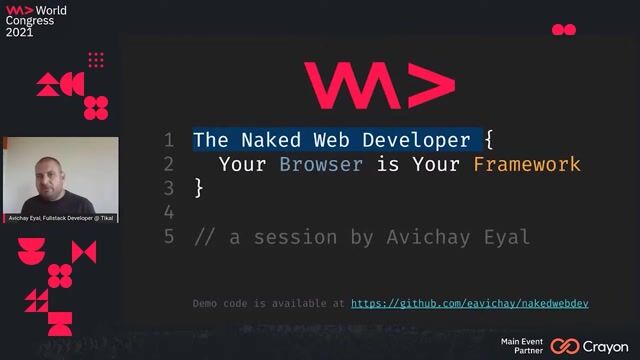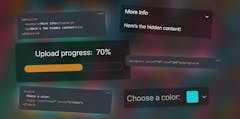Rowdy Rabouw
Extending HTML with Web Components
#1about 3 minutes
Celebrating the end of Internet Explorer 11 support
The retirement of Internet Explorer 11 simplifies web development by removing the need for polyfills for modern features like web components.
#2about 1 minute
Introducing the three core parts of web components
Web components are framework-agnostic, reusable UI elements built from three main technologies: custom elements, HTML templates, and the shadow DOM.
#3about 3 minutes
How to define a new autonomous custom element
Create a completely new HTML element by defining a class that extends HTMLElement and registering it with customElements.define().
#4about 2 minutes
How to extend existing native HTML elements
Modify the behavior of a standard HTML element, like an anchor tag, by extending its specific class and using the 'is' attribute.
#5about 3 minutes
Encapsulating styles and markup with shadow DOM
The shadow DOM isolates a component's internal structure and CSS from the main document, preventing style leaks in or out.
#6about 3 minutes
Styling encapsulated components with CSS variables
Use CSS custom properties (variables) defined on the :host pseudo-class to allow external CSS to customize a component's internal styles.
#7about 1 minute
Exposing internal elements for styling with ::part
The ::part pseudo-element provides a powerful way for users to directly style specific internal elements of a web component from outside the shadow DOM.
#8about 4 minutes
Passing data using properties versus attributes
Use HTML attributes for simple string-based data and JavaScript properties for complex data types like objects or arrays, observing attribute changes with a callback.
#9about 2 minutes
Understanding the web component lifecycle callbacks
Web components have lifecycle callbacks like connectedCallback and disconnectedCallback that fire when the element is added to or removed from the DOM.
#10about 2 minutes
Composing components with default and named slots
Use the <slot> element to create placeholders in a component's template, allowing users to inject their own content into default or named slots.
#11about 3 minutes
How to dispatch custom events from a component
Emit custom events from a web component using dispatchEvent and new CustomEvent() to communicate data and state changes back to the parent application.
#12about 3 minutes
An example of communication between two components
A practical demonstration shows how a list component can dispatch a select event that a detail component listens for to update its content.
#13about 1 minute
Providing fallbacks when JavaScript fails to load
Ensure a good user experience by providing fallback content inside your custom element tag or using a <noscript> tag in case JavaScript is disabled or fails.
#14about 5 minutes
Using web components in Angular, Vue, and React
Web components can be easily integrated into popular JavaScript frameworks like Angular, Vue, React, and Svelte with minimal configuration.
#15about 1 minute
Simplifying development with Lit and Stencil
Libraries like Lit and Stencil offer tools and abstractions that can simplify the process of building and maintaining complex web components.
#16about 4 minutes
Q&A on framework choice and accessibility
The speaker answers audience questions about the benefits of web components over frameworks, browser support for ::part, and ensuring accessibility.
Related jobs
Jobs that call for the skills explored in this talk.
Apaleo
München, Germany
Remote
€65-85K
Senior
JavaScript
.NET
+2
Matching moments
Featured Partners
Related Videos
 46:39
46:39Frameworkless: How to use Web-Components in production?
Tobias Münch
 19:46
19:46Building a framework-independent component library
Tobias Scholz
 25:33
25:33Accessibility with Web Components
Manuel Mauky
 43:08
43:08On tour with heroes == Moving from Angular to WebComponents
Benjamin Glusa
 29:11
29:11Angular Magical directives
Valentine Awe
 28:35
28:35Unlocking Seamless Collaboration: Design-First APIs for UI Components
Lucien Immink
 41:28
41:28Component styling in a JS world — evolve your mental model
Maximilian Heinrich
 42:46
42:46The Naked Web Developer: Your Browser Is Your Framework
Avichay Eyal
Related Articles
View all articles



From learning to earning
Jobs that call for the skills explored in this talk.


Hubert Burda Media
München, Germany
€80-95K
Intermediate
Senior
Node.js
TypeScript

Douglas GmbH
Düsseldorf, Germany
Intermediate
Senior
React
TypeScript

Picnic Technologies B.V.
Amsterdam, Netherlands
Intermediate
Senior
RxJS
Angular
TypeScript

Tech Solutions Gmbh
Berlin, Germany
API
CSS
GIT
HTML
Scrum
+5

Tech Solutions Gmbh
Brandenburg an der Havel, Germany
API
CSS
GIT
HTML
Scrum
+5

Tech Solutions Gmbh
Bremen, Germany
API
CSS
GIT
HTML
Scrum
+5

Tech Solutions Gmbh
Illingen, Germany
API
CSS
GIT
HTML
Scrum
+5
![Fullstack Engineer [React.js, TypeScript, Inline Styling]](https://wearedevelopers.imgix.net/public/default-job-listing-cover.png?w=400&ar=3.55&fit=crop&crop=entropy&auto=compress,format)
CrowdBuilding
Amsterdam, Netherlands
React
DevOps
Node.js
TypeScript
React Native
+3